The joints of the human body withstand the daily burden, so that they become exposed to a variety of damaging factors. Among joint diseases, arthrosis is often found, and it affects both large and small joints. Knee joint arthrosis is a degenerative-dystrophic damage to the knee joint, where the motor activity is interrupted. In the absence of proper treatment, the disease can cause defects.
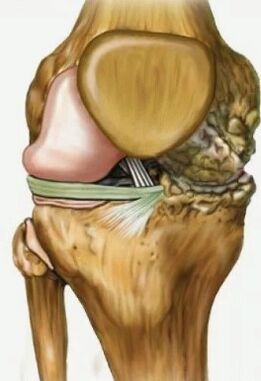
Because the disease causes a characteristic defect in the joints, it is called deforming arthrosis of the knee joint, which accurately describes the common features of the pathology. The disease is chronic and is more often diagnosed in women, with excess weight and lower vein pathology from the feet, but there may be other reasons. Due to age -related changes, people also arise in the elderly.
Young arthrosis can be provoked by injury. As a result of degenerative-dystrophic changes, the cartilage softens, delays and covered with a variety of depth. Next, he stopped meeting his function.
Cause
Various causes lead to the appearance of knee joint deformation arthrosis. Traumatic factors are the cause of common occurrence. Post -traumatic arthrosis may develop due to the reception of dislocation or fracture in the specified zone, as well as meniscus injury. Typically, knee joint gonarthrosis appears in young people actively involved in sports, or among people whose work is associated with increased mobility, lifting and weight transplantation.
Some people know that such damage can be the result of treatment, when the injury itself is cured, but during long -term immobilization there is a blood circulatory disorder in this area. Because of this, gonarthrosis appears.
Increased physical energy to the knee is one of the major factors in the appearance of the disease. Often it affects athletes with continuous active load on the knees. At a young age, arthrosis may not appear, usually rapid changes begin after the termination of physical activity.
There is also a risk of disease in people who, even in adulthood, do not reduce the burden on the joints. In such athletes, the risk of bone fractures and dislocation increases, microtraumas appear. Therefore, after forty years, doctors recommend that athletes reduce the burden, switch to guidance work. Walking and squats are best excluded, as it is a type of activity that mostly loads the knee joint. Often, one limb is affected and left gonarthrosis -right or proper gonarthrosis -is right.
Removal of meniscus is an important factor in the development of knee joint arthrosis. If for some reason menisci is removed, then this in 90 percent of cases leads to the appearance of arthrosis-called baking knee, where the articular joints experience more friction than normal.
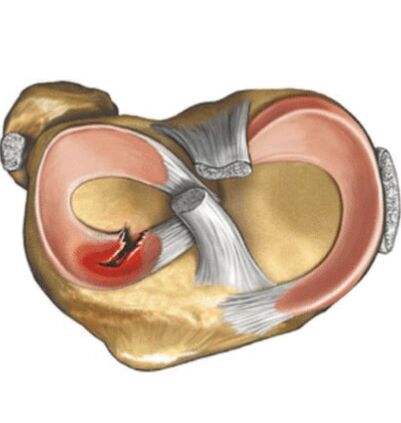
This happens with meniscus arthroscopy - tears - which can be a trigger for knee joint arthrosis
Excessive weight problems are also relevant to people with arthrosis. Excessive weight produces unnecessary pressure on the joints. As a result, the cartilage itself is damaged, but the meniscus. And with excess weight combinations, acute arthrosis threatens varicose veins from the lower leg.
Weak ligamentous tools in some patients are natural, and sometimes ligaments are affected by other diseases. One way or another, weak ligaments cause increased mobility in the joints, so the articular surface is a significant abrasion. The result of a weak ligaments could not be felt for a long time until the patient had true arthrosis symptoms.
Joint pathology also leads to the development of the disease. Often, arthrosis is the cause of arthrosis - inflammation of the articular joints. With arthritis, the typical signs are observed - deterioration in synovial fluid composition, pathological changes in cartilage, swelling, soft tissue redness. Even after osteoarthritis, the chronic process leads to the appearance of arthrosis.
Violation of metabolic processes often leads to the pathology of the musculoskeletal system. Bones and joints do not receive nutrients and minerals, so it is necessary for tissue strength. With the deficiency of the surface of the bone and cartilage it is subject to a destructive process, therefore, even with a slight load, the main arthrosis appears.
Symptom
Knee joint arthrosis is indicated by complex features that are difficult to observe. There are no signs only in the first stage of pathological development, but the second and third degrees provide clear arthrosis symptoms from the knee joint:
- Pain is one of the main signs, which is not indicated by artificial. It is interesting that with the development of arthrosis, the pain cannot be felt even for months or years until the disease is aggravated. Usually, the first signs of pain are discomfort in physical, walking or running, but it also shows itself when the meniscus is pinched. In the second stage of arthrosis, the pain in the joints is felt stronger, and with the third stage of development, painful sensations arise despite rest. The attack worsen even after walking without a strong load on the joints, so patients try to release their knees;
- Deformation - manifestations are becoming more prominent in the third stage of arthrosis development. The knees will retain its normal shape, but it looks slightly swollen, swollen. When arthritis is consolidated, the knees become red, it will become hot and painful;
- Christ with arthrosis appears in the second and third stages of the disease. The crunchy sounds are different from the healthy click, which can sometimes be heard when prolonging and bending the knees. With arthrosis, symptoms are characterized by dry and coarse sounds, which occur significantly and are accompanied by pain;
- Synovitis is the accumulation of a number of fluids in the joint cavity. It is also contained there. But excessive accumulation of volume leads to the development of cysts - baker cysts, which can be determined in the exposed position of the legs, most noticeable;
- Limited mobility in the knee is a typical sign of pathological, as patients first try to protect themselves from the pain, and in the final stages of arthrosis, they cannot bend the limbs. In the third stage of development, the deformation of the knee joint osteoarthrosis (prayer) even leads to loss of movement. The patient adapts to moving on bent feet, using support products.
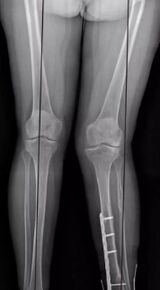
The level of development
Knee joint arthrosis occurs in the development of three degrees.
With 1st degree arthrosis, it hurts and occurs only with the physical energy of the knee joint. Already in the first stage, the fluid in the cavity can accumulate, which in the second and third is already a cyst. With development, pain occurs in the process of movement, but quickly passes. Externally, the deformation of the knee joint is invisible, so the diagnosis of the knee joint arthrosis can be difficult.
Arthrosis pain appears even the external signs of the disease cannot be seen
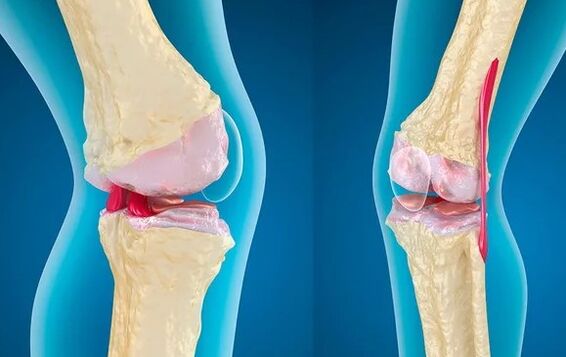
With the second degree disease, damage to cartilage tissue is more important. If you take X -Ray, then the bone growth level is significant on it. With any movement, the pain suddenly appears to the knee, but, back to a simple position, the knee is no longer painful. In the second stage of prayer, you can hear the typical crisis of arthrosis. When developing, problems with extension and knee are worsened. Deformation becomes significant in appearance.
Osteoarthrosis of the knee joint from a third degree is characterized by significant cartilage thinning. Gradually, the cartilage is soaked until the bones are exposed in some areas. Picture X -ray shows a large number of osteophytes - bone growth, salt that appears in the joint cavity. Externally, changes are clearly visible, and patients are worried about persistent pain. It is easy to make a diagnosis-there are adequate visual examination and retigen control.
With the development of this degree, arthrosis can cause full function loss. In any case of pathological development, osteoarthritis of the knee can participate.
Treatment
Conservative
The most active group of drugs against arthrosis is an anti -nonsteroidal drug. These mainly cyclooxygenase-2 inhibitors, they can relieve inflammation, swelling and contribute to rapid recovery. These medicines have significant restrictions, so they cannot be used without the doctor's recommendation. For example, they can worsen stomach ulcers, heart disease, and urinary tract pathology. Anti -steroidal medicine -Non -steroidal inflammation is prohibited during pregnancy.
The second group of funds is chondroprotectors that enhance the characteristics of cartilage. They are used for arthrosis to restore the right cartilage structure, because in the process of resolution it loses very important components - chondroitin and glucosamine. Therefore, almost all chondroprotectors have both of these ingredients, but some drugs are one component. With the help of these medicines, you can help the patient in the first and second stages of the disease, but not in third place, when irreversible changes occur.
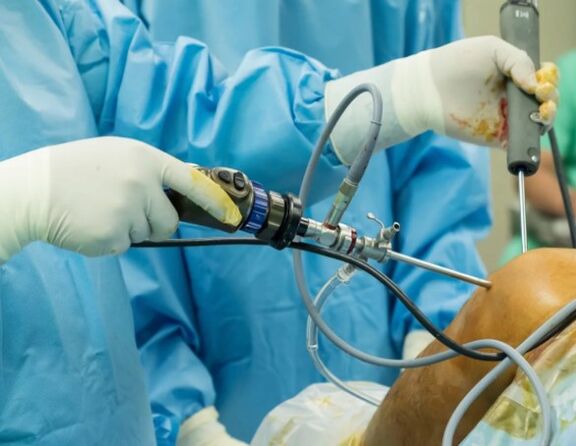
During conservative therapy, doctors will provide recommendations for nutrition. If the patient or the patient has overweight, it is necessary to adhere to the diet to normalize the weight. How to strengthen stable weight - doctors will also tell. It is also not recommended to eat a lot of salt, but it is best to fill your diet with calcium, vitamins and minerals. Jelly, jelly, will be useful.
Operate
The most common type of surgical intervention for arthrosis is arthroscopy, but other interventions are performed. Treatment of knee joint arthrosis is usually performed in the second and third stages, when conservative therapy is no longer helpful.
If necessary, slightly invasive interventions, for example, when collecting fluids in the knee joint, it may be done with a puncture. In the knee joint cavity, the puncture is made and excess fluid is pumped out. This method can be diagnosed with the disease, so it is simultaneously used for treatment. Liquids are taken in the early stages in a minimum, but this has improved the well -being of the patient. Then, after biomaterial studies, other parts were removed, and corticosteroids were introduced into the joint cavity.
Endoprosthetics Sometimes -Always one -way out for patients with third -stage arthrosis
Arthroscopy is the most common. Through a small slice, several tools are introduced on the skin, which allows you to conduct a joint inspection and manipulation needed in it. With the help of arthroscopy, you can remove cloth particles separated from cartilage, but there is always a risk that secondary gonarthrosis will appear.
With severe damage, there is a need to perform periosemani osteotomy. This is a larger effect on the joints, the result is slightly fed and installed at the right angle. After surgery, the recovery is longer, but the effect lasts longer.
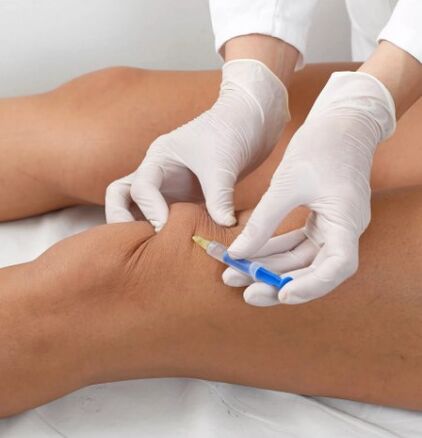
Significant destruction of the articular elements causes the immobilization of the limbs. The joints do not meet its function, which means that it needs to be replaced and you need to do surgery. Endoprosthetics knee joints are expensive surgery, but one that makes it possible to restore movement to patients in the limbs. Various knee prostheses are installed - plastic, ceramic or metal. This is a durable construction that allows you to forget about the problems for decades.
Physiotherapeutic
Physiotherapy methods can only be used when the acute period has passed and the patient recovers.
Some of the techniques used are actively:
- Ozonotherapy is an effect on the affected joints of the ozone, and the substance can be introduced in injection or used as an external treatment. The help of this type for patients is very effective, so it is often used in the treatment of various pathologies, including arthrosis. Treatment makes it possible to activate blood circulation in the problem area, to achieve anti -analgesic and analgesic effects. At the same time, treatment with glucocorticoids is performed;
- Kinesiotherapy - Treatment is performed using a set of special exercises. The load is formed taking into account individual data, and when performing exercises, special simulators are used that strengthen the joints. The difference between kinesiotherapy training and physiotherapy in active effects not only on knee osteoarthritis, but also throughout the organism as a whole.
They use not only ozonotherapy and kinesiotherapy, but also physiotherapy exercises. Good results are made by copyright methods to eliminate knee arthrosis - training in Bubnovsky, Evdokimenko, Dikul. In training and after them, we need to wear a special knee pad - orthosis, to strengthen the right or left knee joints.



















